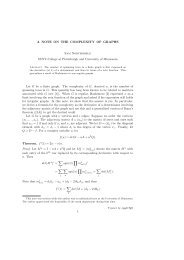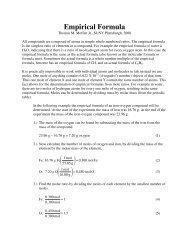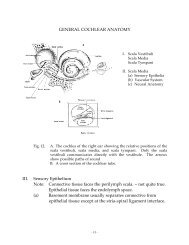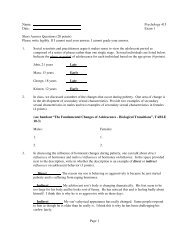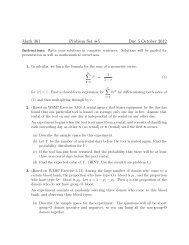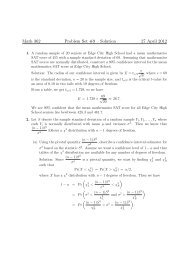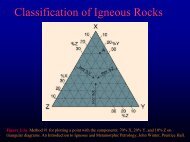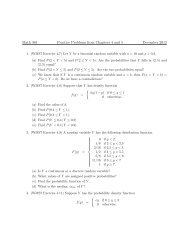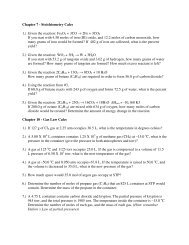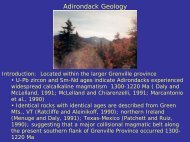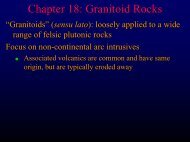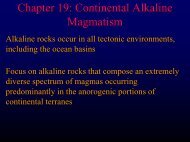Chapter 12 - Layered Mafic Intrusions - Faculty web pages
Chapter 12 - Layered Mafic Intrusions - Faculty web pages
Chapter 12 - Layered Mafic Intrusions - Faculty web pages
Create successful ePaper yourself
Turn your PDF publications into a flip-book with our unique Google optimized e-Paper software.
<strong>Chapter</strong> <strong>12</strong>: <strong>Layered</strong> <strong>Mafic</strong> <strong>Intrusions</strong><br />
Table <strong>12</strong>-1. . Some Principal <strong>Layered</strong> <strong>Mafic</strong> <strong>Intrusions</strong><br />
Name<br />
Bushveld<br />
Dufek<br />
Duluth<br />
Stillwater<br />
Muskox<br />
Great Dike<br />
Kiglapait<br />
Skaergård<br />
rd<br />
Age<br />
Precambrian<br />
Jurassic<br />
Precambrian<br />
Precambrian<br />
Precambrian<br />
Precambrian<br />
Precambrian<br />
Eocene<br />
Location<br />
Area (km 2 )<br />
S. Africa 66,000<br />
Antarctica 50,000<br />
Minnesota, USA 4,700<br />
Montana, USA 4,400<br />
NW Terr. . Canada 3,500<br />
Zimbabwe 3,300<br />
Labrador 560<br />
East Greenland 100<br />
Large or particularly well-studied LMIs exposed in continents<br />
(many in flood basalt provinces)
The form of a typical LMI<br />
The Muskox Intrusion<br />
Figure <strong>12</strong>-1.<br />
From Irvine<br />
and Smith<br />
(1967), In P.<br />
J. Wyllie<br />
(ed.),<br />
Ultramafic<br />
and Related<br />
Rocks.<br />
Wiley. New<br />
York, pp.<br />
38-49.
Layering<br />
layer: any sheet-like cumulate unit distinguished by<br />
its compositional and/or textural features<br />
uniform mineralogically and texturally<br />
homogeneous<br />
non-uniform<br />
uniform vary either along or across the<br />
layering<br />
graded = gradual variation in either<br />
mineralogy<br />
grain size - quite rare in gabbroic LMIs
Uniform Layering<br />
Figure <strong>12</strong>-3b. Uniform chromite layers alternate<br />
with plagioclase-rich layers, Bushveld Complex,<br />
S. Africa. From McBirney and Noyes (1979) J.<br />
Petrol., 20, 487-554.
Graded Layers<br />
Figure <strong>12</strong>-2. Modal and size graded layers. From<br />
McBirney and Noyes (1979) J. Petrol., 20, 487-554.
Layering (or stratification)<br />
Addresses the structure and fabric of sequences of<br />
multiple layers<br />
1) Modal Layering: characterized by variation in the<br />
relative proportions of constituent minerals<br />
may contain uniform layers, graded layers, or a<br />
combination of both
Layering (or stratification)<br />
2) Phase layering: the appearance or<br />
disappearance of minerals in the crystallization<br />
sequence developed in modal layers
3) Cryptic Layering (not obvious to the eye)<br />
Systematic variation in the chemical<br />
composition of certain minerals with<br />
stratigraphic height in a layered sequence
The Bushveld Complex, South Africa<br />
The biggest:<br />
300-400 km x 9 km<br />
The Red Granite<br />
intruded 50-100 Ma<br />
afterwards<br />
Figure <strong>12</strong>-5.<br />
Simplified geologic<br />
Map and cross<br />
section of the<br />
Bushveld complex.<br />
After Willemse<br />
(1964), Wager and<br />
Brown (1968), and<br />
Irvine et al. (1983).
Bushveld Stratigraphy<br />
Basal Series<br />
Thin uniform dunite<br />
cumulates alternating with<br />
orthopyroxenite and<br />
harzburgite layers<br />
The top defined as the Main<br />
Chromite Layer<br />
Figure <strong>12</strong>-6. Stratigraphic sequence of<br />
layering in the Eastern Lobe of the<br />
Bushveld Complex. After Wager and<br />
Brown (1968) <strong>Layered</strong> Igneous Rocks.<br />
Freeman. San Francisco.
The Merensky Reef<br />
~ 150 m thick sequence<br />
of rhythmic units with<br />
cumulus plagioclase,<br />
orthopyroxene, olivine,<br />
and chromite<br />
Figure <strong>12</strong>-6. Stratigraphic sequence of<br />
layering in the Eastern Lobe of the<br />
Bushveld Complex. After Wager and<br />
Brown (1968) <strong>Layered</strong> Igneous Rocks.<br />
Freeman. San Francisco.
Main Zone<br />
The thickest zone and<br />
contains thick<br />
monotonous sequences<br />
of hypersthene gabbro,<br />
norite, and anorthosite<br />
Figure <strong>12</strong>-6. Stratigraphic sequence of<br />
layering in the Eastern Lobe of the<br />
Bushveld Complex. After Wager and<br />
Brown (1968) <strong>Layered</strong> Igneous Rocks.<br />
Freeman. San Francisco.
Also note:<br />
Cryptic layering: : systematic<br />
change in mineral<br />
compositions<br />
Reappearance of Fe-rich<br />
olivine in the Upper Zone<br />
Figure <strong>12</strong>-6. Stratigraphic sequence of<br />
layering in the Eastern Lobe of the<br />
Bushveld Complex. After Wager and<br />
Brown (1968) <strong>Layered</strong> Igneous Rocks.<br />
Freeman. San Francisco.
The Stillwater Complex, Montana<br />
Figure <strong>12</strong>-8. After Wager and Brown (1968) <strong>Layered</strong> Igneous Rocks. Freeman. San Francisco.
Basal Series<br />
Stratigraphy<br />
a thin (50-150 m) layer of norites and gabbros<br />
Ultramafic Series base = first appearance of<br />
copious olivine cumulates (phase layering)<br />
Lower Peridotite Zone<br />
20 cycles (20-150 m thick) of macrorhythmic<br />
layering with a distinctive sequence of lithologies<br />
The series begins with dunite (plus chromite),<br />
followed by harzburgite and then orthopyroxenite<br />
Upper Orthopyroxenite Zone<br />
is a single, thick (up to 1070 m) layer of cumulate<br />
orthopyroxenite
Stillwater Stratigraphy<br />
The Banded Series<br />
Sudden cumulus plagioclase →<br />
significant change from ultramafic rock<br />
types (phase layering again)<br />
The most common lithologies are<br />
anorthosite, norite, gabbro, and troctolite<br />
(olivine-rich and pyroxene-poor poor gabbro)
The Skaergård rd Intrusion E. Greenland<br />
Figure <strong>12</strong>-10. After<br />
Stewart and<br />
DePaolo (1990)<br />
Contrib. Mineral.<br />
Petrol., 104, <strong>12</strong>5-<br />
141.
Magma intruded in a single surge (best<br />
natural example of the crystallization of a<br />
mafic pluton in a single-stage stage process)<br />
Fine-grained chill margin
Stratigraphy<br />
Skaergård rd subdivided into three major units:<br />
<strong>Layered</strong> Series<br />
Upper Border Series<br />
Marginal Border Series<br />
Upper Border Series and the <strong>Layered</strong> Series meet<br />
at the Sandwich Horizon (most differentiated<br />
liquids)
Cross section looking down dip.<br />
Figure <strong>12</strong>-11. After After<br />
Hoover (1978) Carnegie Inst.<br />
Wash., Yearb., 77, 732-739.
The Processes of Crystallization,<br />
Differentiation, and Layering in LMIs<br />
<br />
<br />
<br />
LMIs are the simplest possible case<br />
More complex than anticipated<br />
Still incompletely understood after a half<br />
century of intensive study
Rhythmic modal layering most easily<br />
explained by crystal settling interrupted<br />
by periodic large-scale<br />
convective<br />
overturn of the entire cooling unit<br />
<br />
Reinjection of more primitive magma<br />
may explain major compositional shifts<br />
and cases of irregular cryptic variations
Density currents<br />
<br />
Cooler, heavy-element<br />
element-enriched, enriched, and/or<br />
crystal-laden laden liquid descends and moves<br />
across the floor of a magma chamber<br />
Dense crystals held in suspension by<br />
agitation<br />
Light crystals like plagioclase also<br />
trapped and carried downward
Figure <strong>12</strong>-15b. Cross-bedding in<br />
cumulate layers. Skaergård<br />
Intrusion, E. Greenland. Layering<br />
caused by different proportions of<br />
mafics and plagioclase. From<br />
McBirney and Noyes (1979) J.<br />
Petrol., 20, 487-554.<br />
Figure <strong>12</strong>-15a. Cross-bedding in<br />
cumulate layers. Duke Island,<br />
Alaska. Note also the layering<br />
caused by different size and<br />
proportion of olivine and pyroxene.<br />
From McBirney (1993) Igneous<br />
Petrology. Jones and Bartlett



